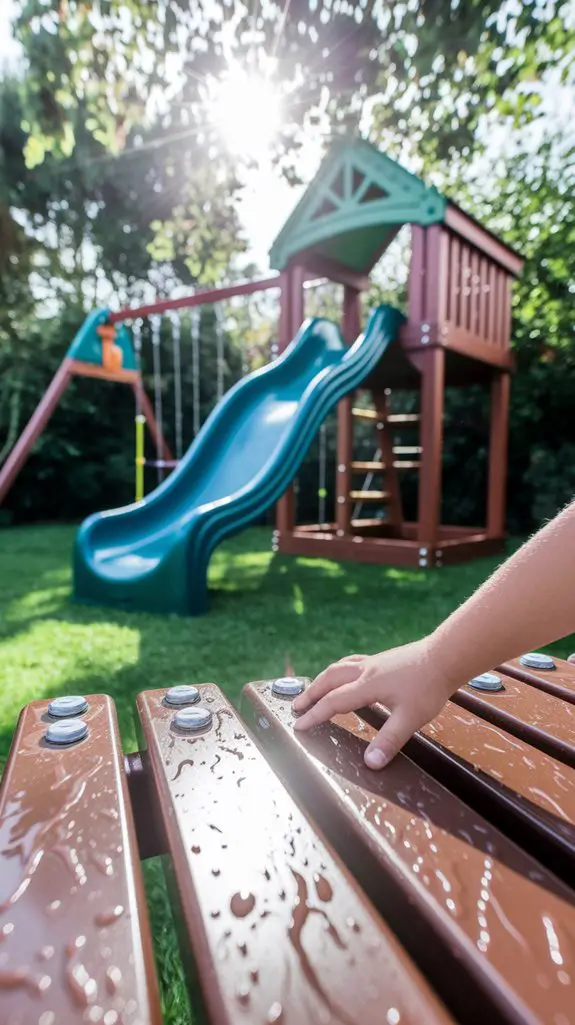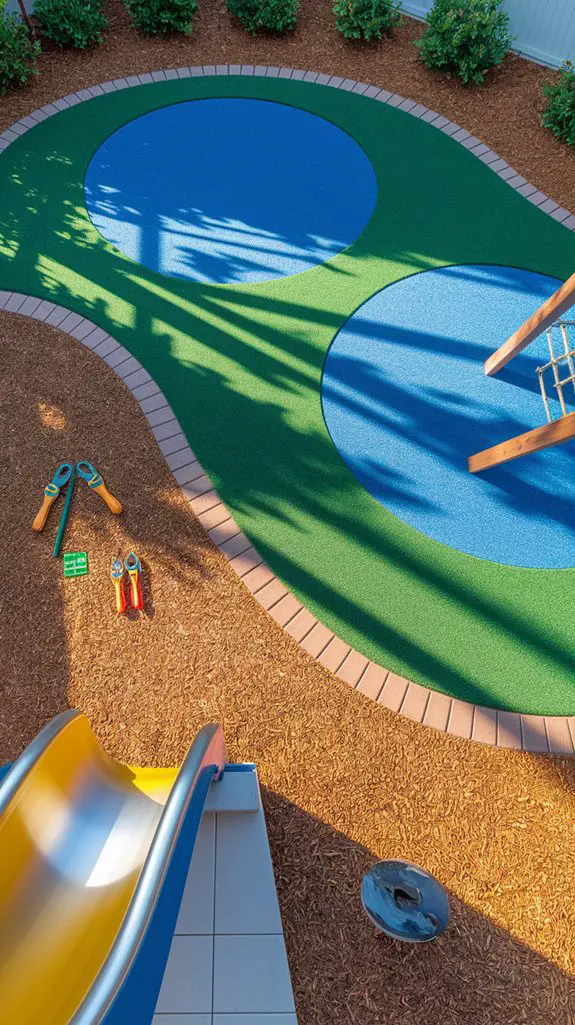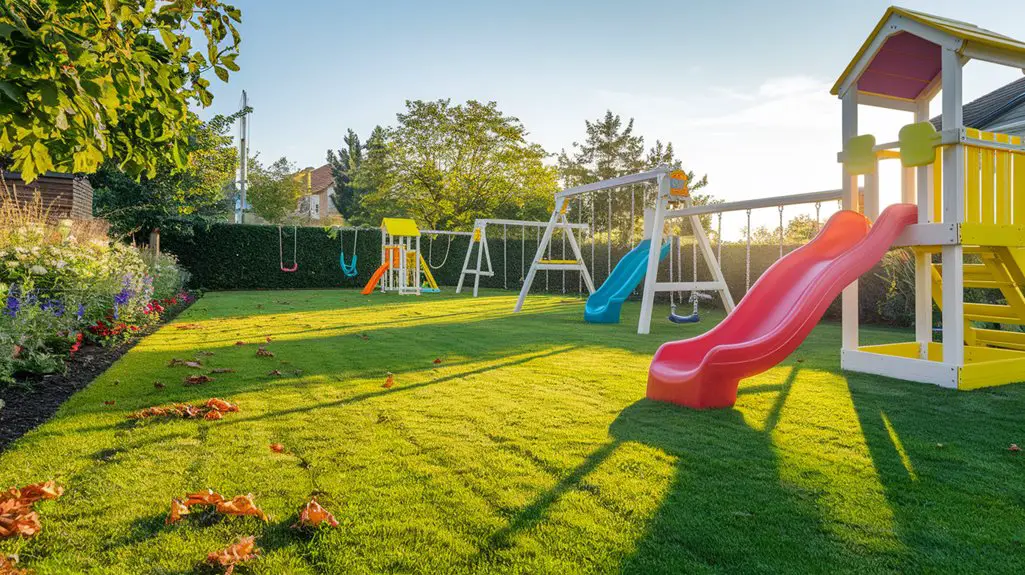Did you know that properly maintained backyard play areas reduce childhood injuries by up to 40%? Your vigilance in regular equipment checks can prevent accidents caused by loose bolts, splintered wood, or unstable structures. You’ll also extend the lifespan of expensive play equipment, saving money while ensuring your children’s safety. Beyond immediate hazards, maintenance prevents long-term issues like rot, rust, and structural failures that might otherwise go unnoticed until it’s too late.
Safety First: Identifying and Fixing Hazards in Play Areas
When it comes to maintaining a backyard play area, safety must be your top priority. Conduct weekly inspections to identify potential dangers like protruding screws, splintered wood, or unstable structures.
Check for trip hazards such as exposed concrete footings, roots, or uneven surfaces. Examine all equipment connections, especially S-hooks, bolts, and chains on swings. They shouldn’t have gaps wider than 1/8 inch when closed.
Guarantee adequate shock-absorbing material beneath all play equipment—9-12 inches of mulch, sand, or rubber surfacing is recommended for equipment higher than 24 inches. Additionally, ensure that the children’s outdoor play area is free from debris and clutter that can lead to accidents.
Remove standing water promptly to prevent slips and mosquito breeding. Trim low-hanging branches that could cause head injuries and regularly inspect for pest infestations that might compromise structural integrity.
Weatherproofing Equipment for Year-Round Play

Beyond addressing safety hazards, proper weatherproofing of play equipment extends its lifespan and maintains safe conditions throughout changing seasons.
Apply water-resistant sealants to wooden structures annually to prevent rot, warping, and splinters. For metal components, remove rust immediately and apply rust-inhibiting paint to prevent structural weakening.
Cover sandboxes when not in use to prevent contamination from animals and moisture. Install UV-resistant canopies over play areas to reduce sun damage to both equipment and children.
In winter, remove snow accumulation from platforms and steps to prevent ice formation and structural stress.
Don’t forget to check fasteners and connections seasonally, as temperature fluctuations cause expansion and contraction that can loosen critical components.
Proper drainage around play areas prevents erosion of supporting ground materials and foundation degradation. Additionally, transforming your backyard into a well-maintained play area can enhance family enjoyment and encourage outdoor activity.
Surface Maintenance: From Mulch to Rubber Mats

The three main types of protective surfacing materials—wood mulch, engineered rubber, and pour-in-place surfaces—require distinct maintenance approaches to uphold their shock-absorbing properties.
Wood mulch demands regular raking to prevent compaction and replenishment every 1-2 years as it decomposes. You’ll need to maintain a 9-12 inch depth for proper fall protection.
Engineered rubber mats require periodic cleaning with mild detergent to remove biological growth and debris. Inspect quarterly for tears or separation that compromise safety.
Pour-in-place surfaces, while durable, need annual professional inspection to identify cracks or areas of degradation. You should immediately repair damaged sections to prevent trip hazards and uphold impact attenuation.
Document your maintenance schedule to guarantee compliance with safety standards and maximize the lifespan of your play surface investment. Additionally, choosing the right protective surfacing materials can significantly enhance the overall safety and enjoyment of the play area.
Preserving Wooden Structures Against Decay and Pests
Wooden play structures require vigilant protection against environmental threats that can compromise both structural integrity and children’s safety. You’ll need to inspect wooden components quarterly for rot, splintering, and insect damage. Apply a child-safe wood sealant annually to prevent moisture absorption and decay. Additionally, managing wildlife populations can help reduce the risk of pest infestations that may threaten wooden structures.
| Threat | Inspection Method | Solution | Frequency |
|---|---|---|---|
| Rot | Probe with screwdriver | Replace affected wood | Quarterly |
| Insects | Look for holes/sawdust | Borate treatment | Bi-annually |
| Splintering | Visual/touch inspection | Sand and seal | As needed |
| UV Damage | Check for graying wood | Apply UV protectant | Annually |
Watch for protruding nails, loose connections, and deteriorating hardware. These compromise structural integrity and create injury hazards. Replace galvanized or stainless-steel hardware immediately when rust appears to maintain joint stability.
Cleaning and Sanitizing Playground Equipment
While structurally sound equipment forms the foundation of playground safety, regular cleaning and sanitizing protocols prevent the invisible threats of pathogen transmission.
You’ll need to implement a systematic approach utilizing appropriate cleaning agents for different surfaces. Metal components require degreasing solutions, while plastic elements benefit from non-toxic disinfectants that won’t degrade materials or leave harmful residues.
Schedule quarterly deep cleaning sessions complemented by monthly maintenance wipes, increasing frequency during flu seasons or after high-usage periods.
Pay special attention to high-touch surfaces: handles, rails, steering wheels, and climbing grips where pathogens concentrate.
Consider installing hand sanitizing stations nearby to reduce cross-contamination.
Document all cleaning activities and maintain a log of sanitization dates.
This record-keeping not only tracks maintenance compliance but also serves as valuable documentation should safety questions arise.
Seasonal Maintenance Checklist for Play Areas
Seasonal shifts demand four distinct maintenance protocols to guarantee your backyard play area remains both safe and functional year-round.
In spring, inspect for winter damage, tighten all fasteners, and apply sealant to wooden structures. Regular backyard play area landscaping tips can enhance the play area’s functionality and aesthetics.
Summer requires weekly inspections for heat-related hazards, UV-damage assessment, and maintaining proper mulch depth of 9-12 inches.
As fall arrives, clear debris regularly, check for water accumulation points, and secure any components that might loosen during winter.
Winter maintenance includes removing snow from platforms, inspecting for ice formation on climbing surfaces, and covering sensitive equipment with appropriate weatherproof materials.
Document all maintenance activities with date-specific logs.
Replace, rather than repair, any components showing structural compromise.
Adherence to this seasonal protocol greatly reduces accident risk while extending your play area’s operational lifespan.
Extending Equipment Lifespan Through Proper Care
Regular maintenance protocols greatly extend the functional lifespan of play equipment, saving you thousands in premature replacement costs. Metal components require quarterly inspection for rust formation—apply rust-inhibiting paint immediately when detected. For wooden structures, apply water-repellent sealant annually and inspect for splinters, cracks, or warping monthly. Tighten all fasteners and hardware bi-monthly, as play-induced vibration naturally loosens connections. Replace plastic components showing UV degradation or brittleness before they fail catastrophically. Lubricate moving parts with manufacturer-approved lubricants every 60-90 days. You’ll maximize equipment longevity by implementing a documented maintenance schedule that tracks each component’s condition and service history. When properly maintained, most commercial-grade play equipment can safely function for 12-15 years instead of the average 7-8 years with neglect. Additionally, engaging in exciting backyard games can motivate kids to enjoy their play area, encouraging regular use and maintenance awareness.
Environmental Considerations in Play Area Upkeep
Environmentally responsible play area maintenance protects both your children and the surrounding ecosystem.
When selecting cleaning agents, opt for biodegradable, non-toxic solutions that won’t contaminate soil or harm wildlife. Avoid petroleum-based preservatives for wooden equipment; instead, use water-based sealants certified for children’s play areas.
Manage water runoff by installing proper drainage systems that prevent erosion and standing water while directing rainwater to appropriate areas.
Consider drought-resistant groundcover that requires minimal irrigation and chemical intervention.
Regular inspection of your play area should include checking for invasive plant species that might introduce allergens or toxic compounds. Additionally, incorporating safe and eco-friendly materials in your play area design can further enhance safety and sustainability.
Additionally, maintain appropriate distance between play structures and trees that may drop hazardous limbs during storms.
Involving Children in Maintenance for Learning Opportunities
Integrating children into the maintenance routine of their play area offers powerful educational experiences while fostering ownership and responsibility. When you involve your children in age-appropriate tasks, you’ll create meaningful learning opportunities about tool safety, material properties, and environmental stewardship. Additionally, maintaining their play area can enhance their experiences in backyard playhouses for imaginative children by ensuring a safe and engaging environment for their adventures.
| Task Type | Skills Developed | Safety Protocols |
|---|---|---|
| Equipment Inspection | Critical thinking, problem identification | Proper glove usage, adult supervision |
| Surface Cleaning | Chemistry concepts, environmental awareness | Safe handling of mild cleaners, respiratory protection |
| Simple Repairs | Fine motor skills, basic carpentry | Tool safety, eye protection, clear work zone |
Assign maintenance roles based on developmental appropriateness. A 5-year-old can help rake mulch while teenagers can learn to check structural integrity of play equipment. You’re not just maintaining a play space—you’re building life skills through practical application.
Conclusion
Prioritizing proper playground preservation pays off profoundly. You’ll prevent painful accidents, protect your investment, and provide a pristine place for children’s development. Don’t delay daily inspections—they’re critical for catching compromised components before catastrophe occurs. Weatherproof wisely, sanitize surfaces, and secure structural stability. Remember: routine remediation reduces risk. Maintaining your backyard play area isn’t just practical—it’s your paramount parental responsibility for ensuring safe, sustainable enjoyment.




